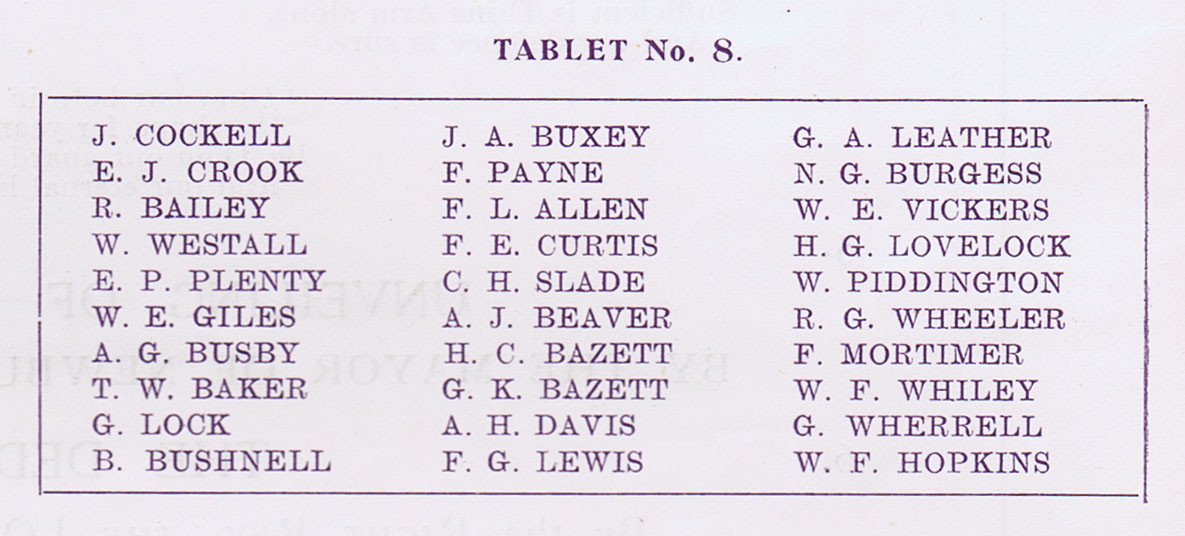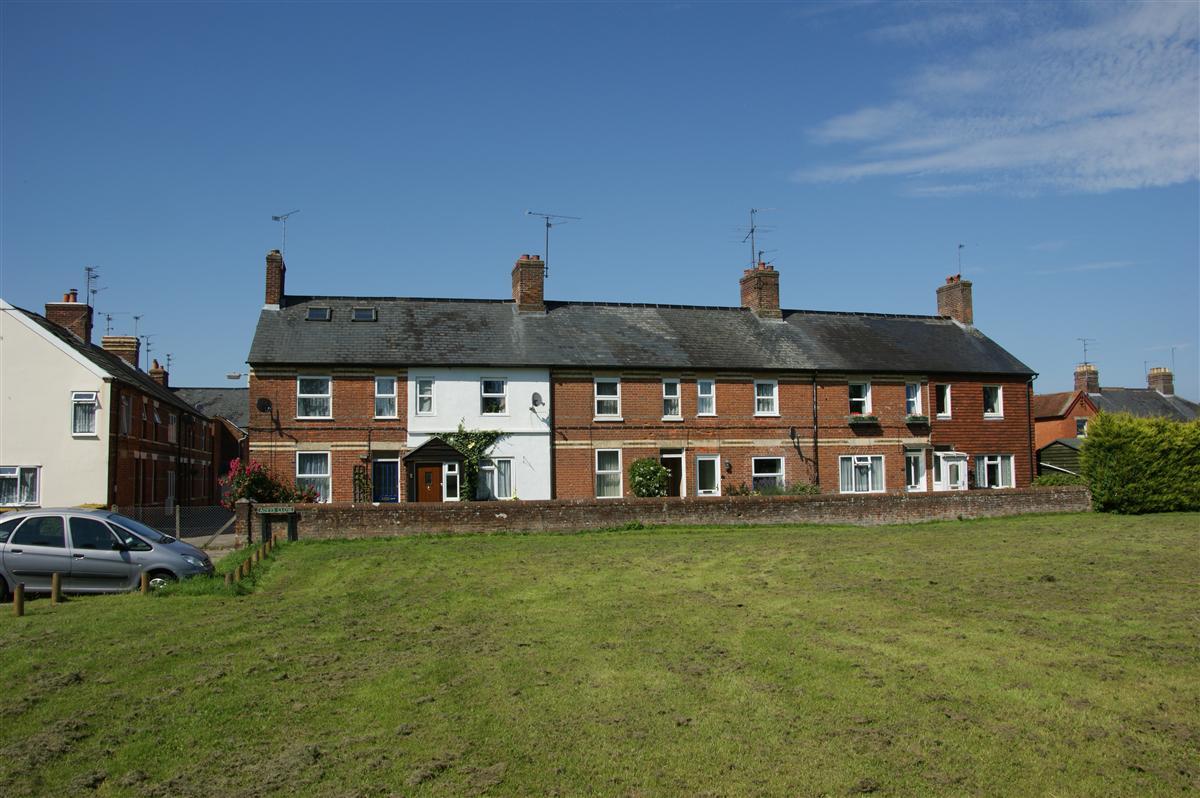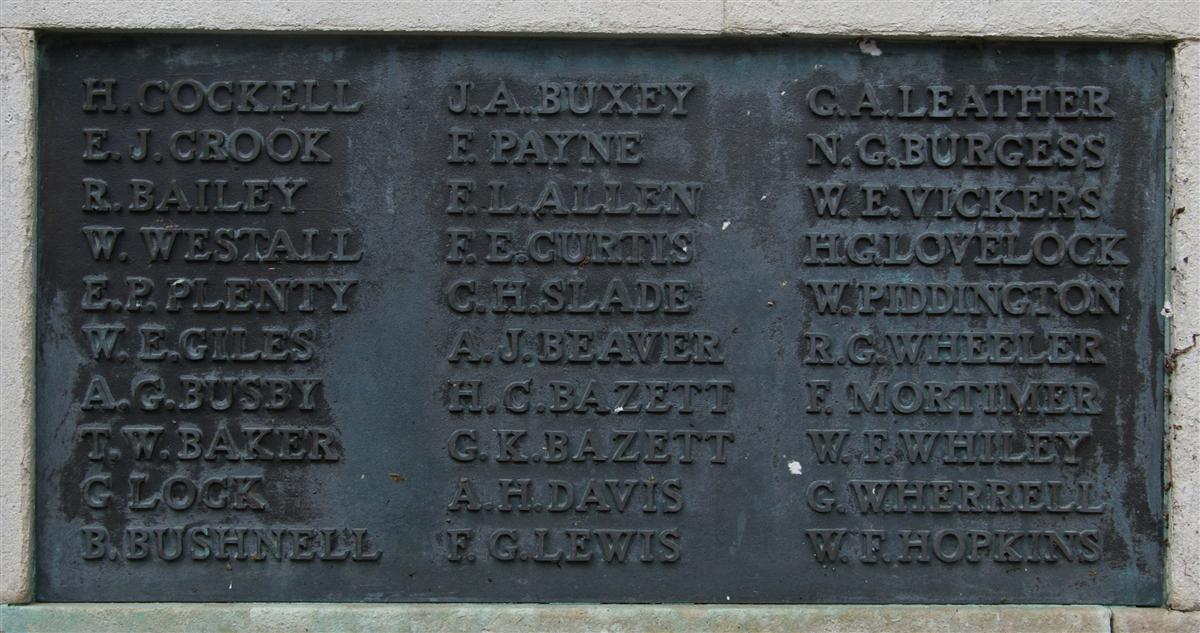Jesse Cockell
201991 Private J Cockell, 1st/4th Battalion, Royal Berkshire Regiment
The first name on panel 9 of the Newbury war memorial is that of H Cockell. However, this is an error almost certainly one of a number of such errors introduced when the original stone tablets were replaced by the current bronze tablets in 1950. A second, contemporary, list of the names on each panel has survived on the programme for the memorial's dedication and unveiling ceremonty on 1 October 1922. The listing for what was designated Tablet 8 on the programme (actually the 9th tablet facing the memorial reading left to right) gives the first entry as J Cockell, readily identified as Jesse Cockell from Adey's Buildings, Stroud Green.

Panel as shown in programme for decication ceremony. |
The only H Cockell commemorated on the Commonwealth War Graves Commission’s roll of honour is Henry James Cockell, who was born in Heywood, Wilts in 1899 and worked for the Great Western Railways as a cleaner before setting off to war. He served as Rifleman 38805 Cockell in the 1st/17th London Regiment (Rifle Brigade) and was killed in action on 24 August 1918. His body lies in grave III.A.15 at the Bray Hill British Cemetery just outside Bray-sur-Somme in France. No Newbury connection has been found.
Jesse Cockell
Jesse was born in early 1883, the seventh of nine children born to William Cockell, a carter, and his wife Mary (née Plank). William and Mary had married in Mary’s home village, Alton Barnes in Wiltshire, before moving to Reading, Newbury, Enborne (where their last four children, including Jesse, were born) and back to Newbury, where they lived at 10 Adey’s Buildings off York Road on the edge of Stroud Green. The Cockells may well have been the first residents of this small terraced house at the edge of the Green, they were there before 1896 while only Nos 1 to 8 Adey’s Buildings are listed in an 1894 directory. Such a large family would have found the house extremely cramped by today’s standard, but this was a new house, built to the standards of the day for working men’s terraced cottages and a huge improvement over the old cramped cottages in the alleys scattered around the town centre.

Adey's Buildings, Nos 14 to 19 face on to Stroud Green, Nos 9 to 13 can be seen leading away to the left. |
By the time the Cockells moved into Adey’s Buildings Jesse was already old enough to have been thinking of a job. At that date school attendance was only compulsory up to the age of eleven. At the time of the 1901 census his occupation is given as a ‘general labourer’ covering a multitude of possible jobs. By the time of the next census in 1911 he was working in his father’s trade as a ‘carman’. Even though the motor lorry was beginning to appear on local roads, it was not until after the war when huge numbers of army surplus lorries became available at low prices that the horse and cart really lost their monopoly of local freight transport. Carters and carmen were the men who drove the horses and carts, both on the local roads and on farms; they would also be responsible for loading and unloading. A young man like Jesse may well have been a carter’s mate (perhaps indicated in 1911 by his father when he listed himself as a carter and his son as a carman).
After the outbreak of war in August 1914 young men rushed to sign up to do their bit, many even fearing that the war would be over before they got into the action. Jesse signed up for service with the Royal Berkshire Regiment’s territorial battalion, the 4th Royal Berks. Territorials signed up for home service, defending Britain. However, it very rapidly became apparent that the various overseas theatres of war, especially France and Flanders, required more men and quickly. One solution was to ask territorials to volunteer for overseas service. This resulted in the splitting of territorial battalions into two, those volunteering for overseas duty and those opting to stick with their home service contract. Thus the Royal Berkshire’s 1st/4th Battalion arrived in France on the last day of March 1915. It is unlikely that Jesse was among their number at this date; his service number indicates that he signed up some months after the outbreak of war and would not have been completed training by the time the battalion first reached the Front. At some point he will have joined the battalion among a draft of fresh troops.
In July 1917 the Allies launched an offensive in Flanders correctly known as the 3rd Battle of Ypres, but often referred to as the Battle of Passchendaele (actually only one later phase the overall battle). Most of the action took place to the north and east of the town of Ypres (Wipers to the Tommies, but known to its inhabitants under its Flemish name of Ieper). The objective was a ridge of land passing through the village of Passchendaele. The second major phase of the offensive, known as the Battle of Langemarck, was launched on 16 August. By this time the 1st/4th Royal Berks was a battle hardened unit, part of 145 Brigade in the 48th (South Midland) Division. The Division took part from the start of the battle, the 1st/4ths reaching their assembly point at 4.30am on 16 August. A detailed report of messages sent from battalion HQ paints a picture of the action. By 6.45am a report to Brigade HQ states that their Right company (A Company) had been badly hit by the enemy barrage (more than half were casualties). C Company had more success, achieving one of their objectives by 7.35am with only 30 casualties. From then on the situation becomes ever more confused. At 10.40am a message is sent to B Company “Remain where you are and be ready to assist Glosters in attacking Green Line or resisting counter attack or making counter attack as the case may be.” Whichever option chosen it was not long before a message was sent to D Company “Please send 2/Lt Crust to take charge of C Coy”. Through the following hours the advance continues, each small conquest having to be defended against counter attacks. The following evening, after over 36 hours of activity with only a brief respite, the battalion was withdrawn from the attack, much reduced in number.
A corporal wrote home:-
| We have just come through the worst battle in which our battalion has been engaged and I am sorry to tell you that our casualties have been rather heavy, but ours are not to be compared with the enemy, on whom we inflicted tremendous losses. I have never been through such fighting and those who were fortunate enough to get through share the same opinion. The battle took place in the neighbourhood of ----- and after fighting which was most violent we were successful in taking our objective. We had to fight almost every inch of the way, so to speak. The German fire was murderous and I myself had so many escapes - I am sure there not many who did not - that I consider myself fortunate to be alive. They had corporate dugouts and their snipers, - well they seemed to be all over the place. I must say that our bombers did splendid work and our artillery was great. The boys although under heavy fire continuously swept over the ground in that gallant manner which has won the good old ----- [1st/4th] such praise. Talk about shells bursting - they were exploding all over the place! One alone killed a couple of fellows quite close to me. When we had taken the position the fighting had not finished by any means. The Huns made counter-attacks in masses and as the successive waves advanced they were broken up and destroyed in great numbers. They suffered hideously from our deadly shell and rifle fire which annihilated them. Indeed they were just like targets on a rifle range and as they advanced for the purpose of retaking the position they were simply mown down. The slaughter was dreadful. They sacrificed men wholesale and vigorous as their assaults were they never achieved their purpose. But oh dear! It was a dreadful affair with fighting going on hour after hour and I can tell you that I never want to go through another battle like it. Many Reading boys have gone under - Martin, Sergeant Parker, Lukeman and Dee being among them. |
Jesse Cockell was one of the casualties of the first day of action. The Commonwealth War Graves Commission records 47 men of the 1st/4th who died that day; of these there were 32, including Jesse, whose bodies were never recovered and who are recorded on the panels of the Tyne Cot Memorial (Jesse’s name appears on Panel 105). As his body was not recovered it is perhaps more likely that he died in the early minutes of the advance as the enemy shellfire inflicted heavy casualties. However, there is not enough information surviving to determine exactly how or where he met his end.
His passing was recorded in a brief announcement in the local paper:

Jesse Cockell's name on Newbury War Memorial, albeit with the wrong initial. (top right) |
NWN 13 Sep 1917 – Killed in Action
COCKELL – Killed in action on August 16, 1917, Pte Jesse Cockell, 1/4 Battalion of the Royal Berks Regt, the dearly loved son of Mr and Mrs W Cockell , of 10, Adey’s Buildings, Stroud Green, Newbury.
Adey’s Buildings (now Adey's Close) was not a lucky address. Several families in this small development lost sons during the war, including the first Newburian to die in the war, Jack Himmons, from next door at No 11, brothers Ernest and Sidney Brooks from No 12, and Alfred Gore from No 7 (Jack Himmons was his brother-in-law). Another pair of brothers John and William Bellinger had been raised in No 16 (their parents moved out in 1913).

Find a memorial :
| Died this day: | |
| 14 January 1902 | |
| A Bosley | |
| Newbury |

Like this site? Show your appreciation through a donation to a great charity.